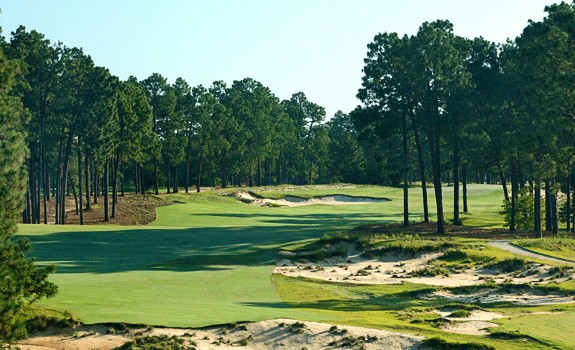
Hole 5: A Lengthy Beast
Pinehurst Number 4:
Gil Hanse’s Stamp on the Nearly Century Old Classic.
Posted by: Rick Parnham
A visit to the remarkable Pinehurst Resort provides the opportunity to enjoy the creations of some of the most noteworthy architects the game has seen. The world-renown resort has its roots dating back to 1895. Envisioned by William Tufts as a southern locale for those looking to escape the cold and snow of the north, Pinehurst has been widely considered the epitome of American golf destinations. Home to nine different championship courses and the newly built Cradle, a superbly fun nine-hole treat, there is a plethora of golf options to satisfy the beginner or most accomplished golfer alike.
Tufts knew the sandhills of North Carolina and the warmer climate would draw vacationers, but also knew that golf was a much needed entity for his resort. Tufts hired none other than Donald Ross, the legendary Scot, to be the person to craft this rolling canvas dotted with pines into a place like no other for golf. Ross was instrumental in the building of the first four courses at the resort. After remaking the original Number 1 in 1898, he began work on three other courses that still owe their beginnings to Ross. The most famous of his designs is Number 2, having all the lore and history surrounding the routing and a lengthy list of major championships being contested on the tortuous greens.
Number 4 resulted from an overwhelming demand for golf at the resort. Upon completion of Number 3 in 1910, Ross began routing and building Number 4. Built and opened in stages, the full 18 hole design was completed in 1919. No other course at the resort has been transformed as often as Number 4, with no fewer than four esteemed architects, Robert Trent Jones, Rees Jones, Tom Fazio and now Hanse, plying their craft to Ross' original routing.
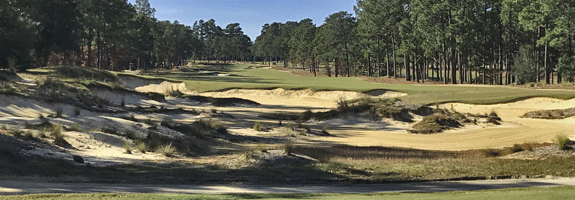
Rugged and Natural
Gil Hanse has become one of the most sought after contemporary architects in recent years. After his successes designing the highly celebrated Olympic layout in Brazil and the terrific addition of the Black Course to the Streamsong collective in Florida, Pinehurst Resort secured his talents to renovate Number 4. His goal in the renovation was to bring back the naturalness of the landscape. Leaving most of the existing corridors in place, Hanse adopted the rugged barren edges of the fairways, similar to the work done by Coore and Crenshaw on Number 2. Gone are the numerous collections of small pot bunkers in the fairway corridors and around green complexes, replaced with larger more playable hazards, or considerably sized swales and collection areas around the greens. A traditional feel is found at many of the greens with a blend of subtle and severe slopes found throughout the round. Many approaches provide for both the aerial assault or a ground attack with each presenting a different challenge.
Selecting a quartet of holes for one of our shot makers features was a daunting task. This varied collection features a wide range of options to get the ball in the hole, with a great mix of old-school design characteristics. The second hole is a truly marvelous par 5. Playing downhill off the tee, the green is reachable with two mighty strikes. The green is perched halfway up a hillside and has a severe cleft dividing it. Getting to the putting surface is the first step, surviving it is the greater challenge. The sixth hole is a beastly par 3 requiring a long iron, or most likely hybrid, to carry the sandy abyss between tee and green. A miss to the right of the generously sized and sloped green will find you hitting nearly straight in the air out of the greenside bunker.
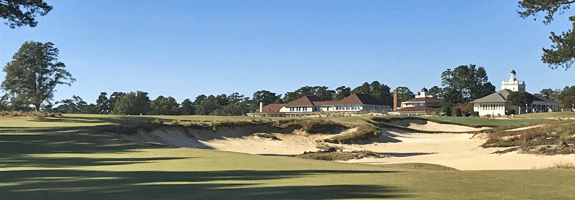
A Grand Finish: The Approach on Number 18
The 13th is a cape-style par 5 hole that is a terrific risk / reward challenge. Slightly downhill off the tee, the fairway doglegs to the left around a large lake. A drive tempting the lake will put you in the "go zone" with a chance at reaching the accessible flat green in the distance with a brave attack completely over water. A safer route short to the putting surface still affords a chance to wedge an approach tight to the pin for a well deserved birdie opportunity. Arriving at the tee of the 16th the card exposes a short, drivable par 4. Be careful with any expectation of an easy birdie, as Hanse has incorporated many subtle swales, a false front and fall aways on this small green, punishing anything hit less than perfectly.
Hanse was blessed with having been given a footprint created by Ross. Being able to update Number 4 and bring back a more traditional feel to the routing with the trendy, wide fairways surrounded by sandy waste areas has created a visually enhanced playing experience. The brand new par 3, 11th is a great addition to the card, bringing a more consistent feel to the short holes while replacing the old 13th, a downhill hole that felt a little out of context in the routing. The design is built to be best experienced by foot with greens blending into tees and the character cut-throughs all enhancing the round. The new incarnation of Number 4 provides a fantastic compliment to its infamous big brother while offering many similarities to Number 2. This remarkable championship test is well worth the visit to Pinehurst Resort itself.
Related Editorial: Pinehurst #4, Pinehurst #9, Pinehurst The Cradle, Dormie Club, Hyland, Legacy, Longleaf, Mid Pines, Mid South, Pine Needles, Pinewild, Seven Lakes, Talamore, Tobacco Road
Contact:
Pinehurst Resort
80 Carolina Vista Dr,
Pinehurst, NC
28374, USA
1-855-235-8507
Pinehurst #4: Par 72
| Tees | Yards | Rating | Slope |
|---|---|---|---|
| Orange | 7227 |
74.9 |
138 |
| Blue | 6961 |
73.7 |
135 |
| White (M) | 6428 |
70.8 |
131 |
| White (L) | 6428 |
76.9 |
140 |
| Green (M) | 5864 |
68.5 |
123 |
| Green (L) | 5864 |
73.8 |
133 |
| Red (M) | 5260 |
65.4 |
116 |
| Red (L) | 5260 |
70.1 |
124 |
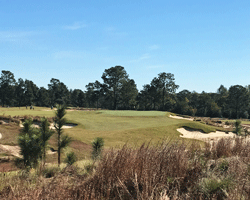
Number 6: Exposed Yet Well Protected



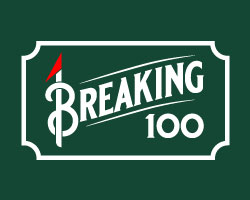

ENEWS